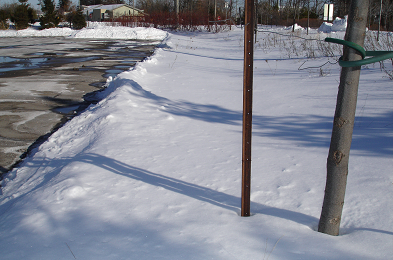Winter Management
Salt and Snow[edit]
Sodium and chloride ions in de-icing salts applied to asphalt areas travel easily with the runoff water. De-icing salt can also increase the mobility of some heavy metals in soil (e.g., lead, copper and cadmium). This can increase the heavy metal concentrations in downstream water (Amrhein et al., 1992; Bauske and Goetz, 1993).
Very few studies have sampled groundwater below infiltration facilities or roadside ditches receiving de-icing salt laden runoff have found concentrations of heavy metals that exceed drinking water standards (e.g., Howard and Beck, 1993; Granato et al., 1995).
To minimize risk of groundwater contamination the following management approaches are recommended (Pitt et al., 1999; TRCA, 2009b):
- Stormwater infiltration practices should not receive runoff from the following areas:
- Where large amounts of de-icing salts are applied (e.g., busy highways), or
- Pollution hot spots (e.g. vehicle fuelling, servicing or demolition areas, outdoor storage or handling areas for hazardous materials, and some heavy industry sites);
- Prioritize infiltration of runoff from source areas that are comparatively less contaminated such as roofs, low traffic roads and parking areas; and
- Apply pre-treatment practices before infiltration of road or parking area runoff.
Freezing and Expansion[edit]
Freezing temperatures can cause problems with pipes and cisterns exposed above the frost penetration line[1]. This maybe a significant issue for rainwater harvesting systems, including residential rain barrels.
IMAGES?
